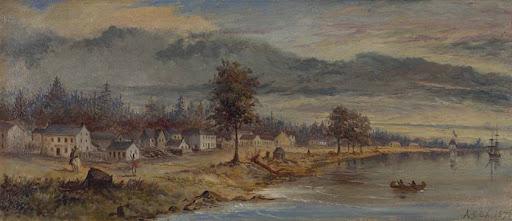The Canadian National Exhibition is
already into its second weekend. For many Torontonians, the annual
exhibition marks the beginning of the end of summer. The back to
school sales have hit the stores, and I've already seen Hallowe'en
candy on the shelves. I think about Hallowe'en most of the year
round but for any normal people out there it may be a bit of a shock
to see it in stores by the second half of August.
August 25, 1919, is the anniversary of
two events associated with the history of the Canadian National
Exhibition. On that date, the Prince of Wales – who would briefly
reign as King Edward VIII before abdicating and becoming the Duke of
Windsor – began a three day visit to Toronto. The grounds of the
CNE was one of several stops that he made while touring through the
city. The First World War had only recently ended, and waves of
patriotism must have swept through the crowds that came out to cheer
on Canada's future King. The Abdication Crisis of 1936 was still
nearly twenty years away, and in the innocent days of 1919, no one
would have guessed that the dashing young Prince would throw the
Crown into peril.
 |
| THEN : The Prince of Wales rides through a crowd of thousands near the old Grandstand at the 1919 CNE. |
 |
| THEN : The Prince of Wales at the 1919 CNE. |
The Prince of Wales also visited a number of military hospitals, as well as the Hospital for Sick Children, which had opened on College Street in 1891, where it remained until the current facility was opened up on University Avenue in 1951.
While in Toronto, the Prince of Wales laid the cornerstone for the Royal Canadian Yacht Club clubhouse on Toronto Island. The previous clubhouse had been destroyed by fire the year before.
 |
| THEN : A gathering of members of the Canadian Weekly Newspapers Association outside the Royal Canadian Yacht Club, Toronto Islands, 1935. |
 |
| THEN : The Prince of Wales with Toronto's Mayor Thomas Langton Church, in 1919, on the steps of Toronto's 1899 City Hall. |
Also on August 25, 1919, the first
international air race to be held in conjunction with the Canadian
National Exhibition took place. The starting point was actually the
Leaside Aerodrome, at Eglinton Avenue and Laird Drive, and the target
destination was the Roosevelt Airfield in Mineola, New York State.
The total distance was 1,142 miles, or 1,838 kilometres. Forty
pilots took up the challenge, with many of those never even
completing the course. The winner was an American, R.W. “Shorty”
Schroeder, but he was disappointed in victory – for some reason,
the cash price of $10,000 was never awarded.
The Leaside Aerodrome had opened in
1917 as an airfield for the Royal Flying Corps. In June of 1918, the
Leaside Aerodrome became the site of the first delivery of airmail in
Canada, with 120 letters delivered by Brian Peck. Today, a plaque
stands near the site of the old Leaside Aerodrome. The last hangar
at the old aerodrome was not taken down until 1971, and today, the
area is covered is home to a number of small business and industrial
buildings.
 |
| NOW : A plaque near the site of the Leaside Aerodrome describes the history of Canada's first Air Mail delivery. |
 |
| THEN : Packages destined for the T. Eaton Company's Toronto location arrive at the Leaside Aerodrome in 1928. |
2013 marks 135 years of the Canadian
National Exhibition on its current locations. If you can take the
crowds, don't mind the vendors, and can enjoy the bright lights and
cacophony of sounds of the Midway at night, then the annual CNE is a
great way to mark the last real weekend of summer. The fair grounds
have changed dramatically over the years, but the CNE has certainly
become an annual end-of-summer tradition in Toronto.
_________________________________________________
If you're free, join me for an “After
Dark” ghost tour of the CNE grounds this coming Monday and
Wednesday night, August 26th and 28th. Tours
start at a sign very close to the admission booths right inside the
Princes' Gates. Come through the gates, and turn right, and you
should see the sign, or simply contact me at
richard@muddyyorktours.com
for more information (or you can look up “Muddy York Walking Tour
Group on facebook). Tours are free with admission, and admission to
the grounds is only $5 after 5 o'clock. Tours start at 7 o'clock and
9 o'clock each of those two evenings. For more information you can
visit the CNE's website here.
We're always planning special events and tours. Last night, we held an indoor ghost tour of Mackenzie House Museum for a few dozen of our regulars. If you're interested, the best way to find out about these special events is through our facebook group, which you can find here.






,_City_of_Toronto,_Upper_Canada.jpg)











